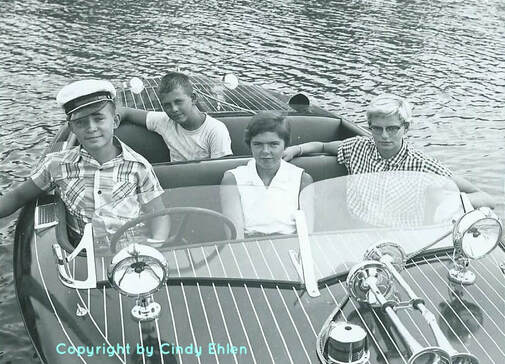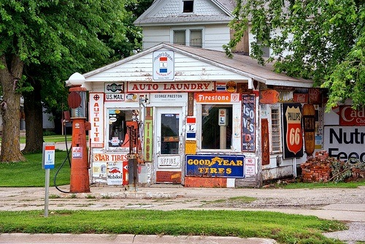Jim Pech
Belle Plaine Farmer
Funk Bros. Historian
In 1953 the Pech farm located in the southeast corner of Belle Plaine was leased, and for the next 20 plus years served the company as its Research Farm and was used for sales promotions and for their Research Lab. The previous lab was located on the John Pingel farm north of town at the intersection of old Highway 131 and No. 30. The Pech farm also served to raise hogs and cattle to use much of the discard corn from the processed seed.
In 1959 the land south and west of the Emerson School property was purchased. This was about 14 acres, and upon it was constructed the new main office buildings and 2 large warehouse buildings. One of these warehouses was temperature controlled to insure top quality seed. At this time Funks had 19 district sales managers. Temporary harvest employees were paid $1.00 to $1.25 per hour.
In 1964 Funks had 120 regular employees and hundreds of temporary employees.
In 1967 the company was purchased by CC International, Inc. Funk Bros. See Company was then named Funk Seeds International, Inc. Funks “G” seed was now introduced in Europe and other foreign countries. From the small acreage in 1935, the production of seed corn grew to 14,042 acres in 1967.
In 1974 Funk Seeds International, Inc. was purchased by Ciba-Geigy and so came the end of Funk Bros. Seed Company.
I’ve spent a lot of time on the rise and full fo Funk Bros. Seed Company. Many activities took place out on the acres. Detasseling was one activity not always looked forward to by regular employees. It was a hot, wet, dirty job, but was looked forward to by many kids for spending money and helped pay for school supplies. There were many headaches controlling kids. A lot fo stories can told about detassling.
Two kids from Brooklyn stayed with their Grandma in Belle Plaine. She took them to their field south of Belle Plaine in the morning and picked them up in the evening. The second day the supervisor could not find them and found they had worked a while in the morning, hitchhiked to Des Moines and got back in time for Grandma to pick them up.
It was a sin to pull leaves with the tassels. Research conducted by people in the industry had proof that yield and seed quality was reduced. However, now all seed companies mow off about a third of the tope leaves using a machine. So much for research done in offices.
In a research lab, controlled breeding was done by using bags to cover the silks and bags to collect pollen and transfer the pollen to make the cross. As many as 30 to 40 thousand pollinations were made. There was a lab in Belle Plaine and one in Minnesota. These were worked by Belle Plaine employees.
It took a lot of bags, paper clips, staples and tags to produce new strains of corn. Each ear has to be identified before being planted the next year.
Chad McMillin’s invention.
Foundation Seed was produced at Bloomington and Belle Plaine with the early maturities at Belle Plaine and later maturities at Bloomington. This is the seed used to produce the seed for the customers and furnished to all of the Associate Growers to produce Funk’s “G.”
Funs were good for Belle Plaine and Belle Plaine was good for Funks.
The company cooperated with all Belle Plaine activities. They sent trucks and employees on town clean-up days.
Funks employed local area truckers, Dick Overturf, Earl Fisher, Neil Strawhorn, Pansy Sankot, Dean McLeod, Dean Carl, and Fisher to name a few.
We had many employees functions, the annual Christmas party held at the American Legion or the Belle Plaine Country Club. There were field days, and in the summer the grilled chicken potluck supper, the chicken prepared by an Ames concern. The children looked forward to the Easter Egg Hunt.
In the building now occupied by Norgaard, we had entertainment consisting of pool tables, a juke box and dance floor, duck pin bowling alley and monthly family potlucks.
Funks employed people for temporary jobs in the office, in advertising, planting, plant selection, detasseling, harvesting, and in the warehouse.
We had employee benefits, a profit sharing plan and insurance.
Through the years some of the office workers were Louise Conrad, Alice Clemmer, Betty Rabe, Alma Pech, Gladys Hecht, Joan Burrows, Rosie Uchytil, Beverlee Sherwood, Wilma Bevins, Millie Snyder, Marg McMillin and Nancy Wright.
There were marriages within this Funk group—Gladys Sikir and Russ Hecht, Jim and Alma Pech, Betty Mall and Rich Rabe, Jim and Rosie Johnson Uchytil, Chad and Marg Monroe McMillan, and Chuck and Arlene Sindt Rabe.
Belle Plaine Farmer
Funk Bros. Historian
In 1953 the Pech farm located in the southeast corner of Belle Plaine was leased, and for the next 20 plus years served the company as its Research Farm and was used for sales promotions and for their Research Lab. The previous lab was located on the John Pingel farm north of town at the intersection of old Highway 131 and No. 30. The Pech farm also served to raise hogs and cattle to use much of the discard corn from the processed seed.
In 1959 the land south and west of the Emerson School property was purchased. This was about 14 acres, and upon it was constructed the new main office buildings and 2 large warehouse buildings. One of these warehouses was temperature controlled to insure top quality seed. At this time Funks had 19 district sales managers. Temporary harvest employees were paid $1.00 to $1.25 per hour.
In 1964 Funks had 120 regular employees and hundreds of temporary employees.
In 1967 the company was purchased by CC International, Inc. Funk Bros. See Company was then named Funk Seeds International, Inc. Funks “G” seed was now introduced in Europe and other foreign countries. From the small acreage in 1935, the production of seed corn grew to 14,042 acres in 1967.
In 1974 Funk Seeds International, Inc. was purchased by Ciba-Geigy and so came the end of Funk Bros. Seed Company.
I’ve spent a lot of time on the rise and full fo Funk Bros. Seed Company. Many activities took place out on the acres. Detasseling was one activity not always looked forward to by regular employees. It was a hot, wet, dirty job, but was looked forward to by many kids for spending money and helped pay for school supplies. There were many headaches controlling kids. A lot fo stories can told about detassling.
Two kids from Brooklyn stayed with their Grandma in Belle Plaine. She took them to their field south of Belle Plaine in the morning and picked them up in the evening. The second day the supervisor could not find them and found they had worked a while in the morning, hitchhiked to Des Moines and got back in time for Grandma to pick them up.
It was a sin to pull leaves with the tassels. Research conducted by people in the industry had proof that yield and seed quality was reduced. However, now all seed companies mow off about a third of the tope leaves using a machine. So much for research done in offices.
In a research lab, controlled breeding was done by using bags to cover the silks and bags to collect pollen and transfer the pollen to make the cross. As many as 30 to 40 thousand pollinations were made. There was a lab in Belle Plaine and one in Minnesota. These were worked by Belle Plaine employees.
It took a lot of bags, paper clips, staples and tags to produce new strains of corn. Each ear has to be identified before being planted the next year.
Chad McMillin’s invention.
Foundation Seed was produced at Bloomington and Belle Plaine with the early maturities at Belle Plaine and later maturities at Bloomington. This is the seed used to produce the seed for the customers and furnished to all of the Associate Growers to produce Funk’s “G.”
Funs were good for Belle Plaine and Belle Plaine was good for Funks.
The company cooperated with all Belle Plaine activities. They sent trucks and employees on town clean-up days.
Funks employed local area truckers, Dick Overturf, Earl Fisher, Neil Strawhorn, Pansy Sankot, Dean McLeod, Dean Carl, and Fisher to name a few.
We had many employees functions, the annual Christmas party held at the American Legion or the Belle Plaine Country Club. There were field days, and in the summer the grilled chicken potluck supper, the chicken prepared by an Ames concern. The children looked forward to the Easter Egg Hunt.
In the building now occupied by Norgaard, we had entertainment consisting of pool tables, a juke box and dance floor, duck pin bowling alley and monthly family potlucks.
Funks employed people for temporary jobs in the office, in advertising, planting, plant selection, detasseling, harvesting, and in the warehouse.
We had employee benefits, a profit sharing plan and insurance.
Through the years some of the office workers were Louise Conrad, Alice Clemmer, Betty Rabe, Alma Pech, Gladys Hecht, Joan Burrows, Rosie Uchytil, Beverlee Sherwood, Wilma Bevins, Millie Snyder, Marg McMillin and Nancy Wright.
There were marriages within this Funk group—Gladys Sikir and Russ Hecht, Jim and Alma Pech, Betty Mall and Rich Rabe, Jim and Rosie Johnson Uchytil, Chad and Marg Monroe McMillan, and Chuck and Arlene Sindt Rabe.

